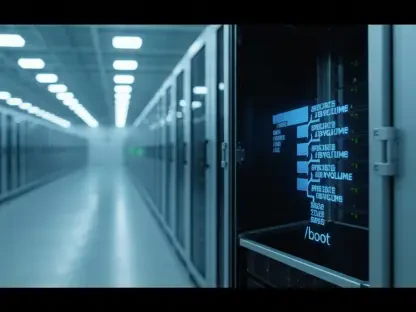The modern Marine Transportation System (MTS) is a linchpin in U.S. commerce, military preparedness, and economic vitality. As a cornerstone of national infrastructure, it includes myriad components ranging from ships and ports to inland waterways, connected by a network of rail and road systems. This intricate web forms the backbone of maritime transport, seamlessly integrating the U.S. into global supply chains. The U.S. Coast Guard (USCG) is at the forefront of ensuring the MTS’s safety, security, and efficiency, overseeing a staggering $5.4 trillion in annual economic activity. With an increasing reliance on digital technology for operational efficiency—spanning from crane management to tracking cargo—cybersecurity has emerged as a pivotal factor in fortifying this essential infrastructure against rising cyber threats.
Growing Need for Cybersecurity in Maritime Systems
Challenges and Digital Threats
The integration of digital systems in the maritime sector has introduced vulnerabilities that were previously unimaginable. Modern ports have transformed into high-tech hubs, blending traditional operational technology (OT), Internet of Things (IoT), and Information Technology (IT) for complex operations such as crane control, container management, logistics, and maintenance. Unfortunately, a significant portion of these systems was originally developed without a cybersecurity focus. As a result, they are exposed to lateral movements and disruptive ransomware attacks that target the merged landscape of business IT and operational infrastructure.
Cloud adoption and proliferation of unmanaged IoT and IIoT devices have further expanded potential attack surfaces within the MTS, amplifying the risk of intrusion. Incidents in the past few years have highlighted critical vulnerabilities where cyberattacks halted crane operations, disrupted logistics, and compromised safety—all escalating concerns regarding national security and economic stability. By integrating robust cybersecurity measures, the maritime industry can defend against these persistent and evolving threats, which pose an alarming risk to the industry and, by extension, to the economy at large.
Notable Cyber Incidents
Several high-profile cyber incidents have underscored the pressing need for enhanced cybersecurity measures within the maritime domain. The 2017 ransomware attack on A.P. Moller-Maersk, one of the world’s largest shipping companies, is a case in point. This attack paralyzed operations across 17 global ports, including the Port of Los Angeles, wreaking havoc across logistics chains that took weeks to normalize. Another striking example is the 2018 cyberattack on the Port of San Diego, which disrupted internal IT operations, although marine traffic continued unaffected.
More recent breaches have been equally enlightening; a suspected state-sponsored attack exploited a web application vulnerability in the Port of Houston. Although thwarted, this incident triggered a federal investigation, illustrating the persistent dangers that maritime systems face. Similarly, in 2022, a ransomware attack severely disrupted India’s Jawaharlal Nehru Port Trust, slowing down container handling and cargo movements as IT systems went offline for recovery. These incidents highlight the vulnerabilities and potential disruptions inherent in maritime operations, demonstrating the urgent need for robust cybersecurity protocols to safeguard this critical infrastructure.
USCG’s Enforcement and Regulatory Mandates
Evolution of Cybersecurity Frameworks
The U.S. Coast Guard’s mandate related to cybersecurity has evolved significantly in recent years, transitioning from issuing best-practice guidelines to enforcement of stringent cybersecurity standards across the MTS. Since the development of the Maritime Transportation Security Act (MTSA) in 2002, ports have been required to create and maintain security plans. In subsequent years, particularly from 2020 onwards, cybersecurity formalized into the regulatory realm with updates to 33 CFR Part 105 and 106, compelling port authorities to identify and mitigate computer system vulnerabilities.
In response to emerging cyber threats, the USCG finalized new rules requiring comprehensive cybersecurity measures, including dedicated incident response plans, cyclical risk assessments, specific cybersecurity officer appointments, regular workforce training, and rigorous access management. Port operators are encouraged to align their programs with the National Institute of Standards and Technology Cybersecurity Framework (NIST CSF 2.0) and NIST SP 800-82r3 for robust IT and OT security guidance. These measures are designed not only to comply with federal regulations but to cultivate a resilient cybersecurity culture within the maritime industry.
Implementation and Impact
The implementation of USCG regulations has instilled a proactive approach across maritime operators, who must now define clear roles, establish procedures for incident response, and devise ongoing improvement strategies. Essential practices such as logging, encryption, segmentation, and supply chain risk management have become core elements of the regulatory framework. Reporting incidents to the National Response Center has been prioritized to ensure a streamlined response to cyber threats.
Port security teams, even those constrained by personnel limits, can meet these compliance obligations through intelligent automation and cybersecurity solutions. Complying with these standards not only protects essential maritime operations but also reinforces national economic security. The mandates have emphasized preparedness and continuous adaptation, encouraging technology adoption that enables swift detection and response, thereby minimizing potential risks to maritime operations and the broader economy.
Technological Solutions in Maritime Protection
Advanced Threat Detection
Advanced technological solutions are playing an indispensable role in securing maritime environments against a mounting wave of cyber threats. Notably, companies like Darktrace have revolutionized threat detection through AI-driven security systems that offer comprehensive IT, OT, and Cloud coverage pivotal for maritime operations. Darktrace uses Self-Learning AI™ to establish a “pattern of life” for each device, user, and network segment, a crucial feature for identifying real-time anomalies and zero-day threats.
This innovative model moves beyond traditional security mechanisms, offering end-to-end visibility and continuous adaptation to evolving device configurations and network activities. Especially in diverse and distributed OT environments, where anomalous activity frequently occurs, the ability to rapidly classify and inventory assets—even obscure or custom-built systems—delivers unparalleled strategic value. By reflecting the realities of modern high-tech port environments, AI-driven security provides a critical layer of defense to ensure operational safety, efficiency, and compliance with USCG mandates.
Deployment and Incident Response
Darktrace’s approach to cybersecurity addresses the specialized needs of maritime settings, often constrained by traditional SaaS models. It offers robust edge deployment solutions, facilitating seamless integration directly into crane networks and terminal enclosures without extensive configuration. These systems operate independently of cloud dependencies, ensuring swift and secure updates alongside resilient fleet management. Importantly, they support air-gapped systems crucial for maintaining isolation in sensitive environments.
Beyond deployment, AI technology aids in enforcing segmentation and real-time threat containment while preserving operational integrity. Autonomous response capabilities allow for spontaneous identification and mitigation of rogue activities, safeguarding against threats without human intervention. During non-operational hours, this capability is particularly valuable, offering smart defenses when team presence is minimal. Darktrace’s robust technology framework ensures the operational continuity and integrity of port systems, offering a dependable shield against evolving cyber threats.
Building Resilience in Maritime Cybersecurity
Enhancing Supply Chain Integrity
Future-facing cybersecurity in the maritime industry extends beyond direct operational protection to encompass upstream supply chain integrity. Darktrace enhances supply chain security through unique in-house sensor and appliance engineering, eliminating dependence on third-party data sources. This self-sufficient approach allows ports to have increased confidence in their cyber awareness, bolstering their capability to fend off sophisticated supply chain attacks.
The complex landscape of critical infrastructure supply chains necessitates comprehensive security measures. By deploying sensors that cover every potential threat vector and presenting an accurate real-time assessment, Darktrace ensures that port operators can address vulnerabilities before they affect the broader chain. This proactive strategy enhances port operators’ readiness to defend against supply chain breaches, ultimately supporting long-term operational viability and national security interests.
Continuous Adaptation and Future Directions
Continuous adaptation of cybersecurity strategies and technologies is pivotal for maintaining effective defense mechanisms within the maritime industry. By leveraging artificial intelligence and self-learning models, ports can create environments that respond dynamically to new threats, achieving a balance between innovative technologies and established security protocols. This delicate balance fosters an evolving cybersecurity posture capable of protecting against sophisticated threats while driving operational efficiency.
A forward-thinking approach emphasizes ongoing investment in next-generation technologies, real-time threat intelligence, and an adaptable cybersecurity workforce. Maritime operators are urged to align cybersecurity initiatives with broader digital transformation strategies. As cyber threats increasingly impact operational continuity and national economies, ports must prioritize cybersecurity as a core operational function, fostering resilience in surviving and thriving amidst an ever-evolving threat landscape.
The Path Forward in Maritime Cybersecurity
The maritime industry is actively enhancing its cybersecurity frameworks and technological solutions, marking significant strides in securing its digital infrastructure. This advancement reflects a shift from a reactive stance on cybersecurity to a proactive one, empowering port operators with essential tools to defend crucial economic and strategic interests. By nurturing a culture focused on constant vigilance and adaptation, the maritime transportation system is strategically preparing to tackle the evolving landscape of cybersecurity threats. This proactive approach not only fortifies the maritime sector’s defenses but also ensures the stability and security of the wider economy. The ongoing commitment to cybersecurity in the maritime industry underscores its critical role in international trade and global supply chains, where vulnerabilities can have far-reaching impacts. As cyber threats become increasingly sophisticated, the maritime industry’s dedication to continuous enhancement and adaptation of security measures positions it well to maintain operational integrity against potential incursions. Through these committed efforts, the industry is paving the way for better resilience and safety in the digital era, protecting both its own interests and those of the broader economic ecosystem.









